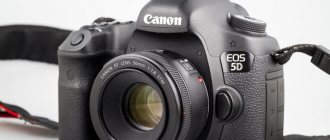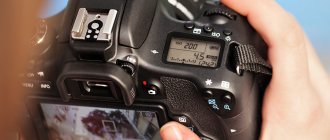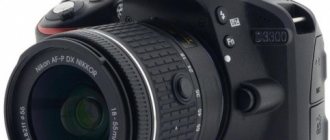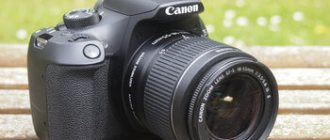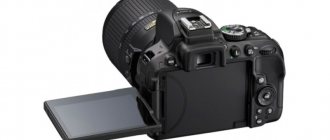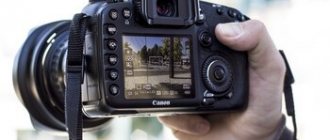Digital cameras are the most common in the modern world. One type or another of these cameras is found in literally every home. They are used by both people who are not interested in photography to capture memorable moments, as well as professional photographers. This article will talk about what types of digital cameras exist and what advantages and disadvantages each of them has. After all, equipment in this category is of the greatest interest, and the cost can vary tenfold.
Fully automatic compact cameras
This type of digital camera independently selects all settings. That is why it is very easy to use: all that is required of the photographer is simply to point at the desired frame and press the shutter button. If necessary, the flash will automatically fire, increase the exposure or change the white balance. This type has quick settings related to the type of shooting taking place. You can select the desired mode, for example, “portrait”, “landscape”, “macro”. By going to the menu, you can manually set the ISO values, white balance, turn the flash on or off, and on some models, control its strength.
Digital cameras of this type usually do not have very good picture quality. You can get a sharp and detailed photo only in good lighting. Also, usually such cameras have a small digital zoom, and the optics are not very high quality. These criteria are important even for beginner photographers, but using compact digital cameras is great for capturing memorable moments just for yourself, family and social media. The cost of such cameras starts from about 2 thousand rubles.
The advantages of such models:
- Small in size, the “compact” will easily fit into your pocket;
- Automatic adjustment, you do not need to have any experience in shooting to use this technique;
- A considerable part of the models are powered by ordinary AA batteries, which can be purchased in almost any part of the world;
- Low cost.
Minuses:
- It is unlikely to obtain truly high-quality images;
- Poor quality optics;
- The lack of manual adjustment of parameters is also a disadvantage, since everyone, even slightly familiar with the shooting process, strives to improve the result;
- Small battery capacity;
- No viewfinder.
Nikon Z system mirrorless cameras
Nikon Z50 Kit 16-50mm
This mirrorless camera is perfect for fine art photography and videography and captures the brightest moments of travel and family celebrations. It is quite compact, but at the same time has wide functionality: quick switching between video and photo shooting modes, the ability to easily pair with other devices, and a built-in tilting monitor. A 1.5 crop (24×16) mm CMOS matrix is installed here. Its minimum light sensitivity is 100 ISO, and its maximum is 51,200 ISO. There is a built-in flash. Focus modes and white balance can be adjusted manually, automatically, or using preset modes. The lenses here are interchangeable. The package includes Nikon NIKKOR Z DX 16-50mm f/3.5-6.3 VR. It has an optical image stabilizer. The battery lasts for 320 shots.
Nikon Z5 Body
The mirrorless camera is compatible with a wide range of compact full-frame lenses. A full-frame 24.3-megapixel CMOS sensor is installed here. Light sensitivity varies from 100 to 51,200 ISO. A special feature of the camera is the vibration reduction system along five axes. Therefore, you can use a long shutter speed. Includes NIKKOR Z 24-50mm lens. It is the smallest full-frame zoom lens on the market today. You can purchase other lenses in the NIKKOR Z series. The camera also features a hybrid autofocus system that quickly and accurately captures objects in the frame. The camera can be used to shoot 4K Ultra HD video. Available wireless interfaces are Wi-Fi and Bluetooth.
You can choose and buy a camera for amateurs and professionals in the Shop.by catalog.
Cameras with advanced settings
This type is suitable for people who understand the settings a little better. Cameras of this type already have photo shooting modes, which expands the range of possibilities. Here you can often find several modes, such as:
- Shutter priority mode, which is indicated by the symbols Tv or S;
- Aperture priority mode, with Av or V symbols;
- Manual mode, indicated by the M symbol.
Thanks to this, you can control the shutter speed or aperture, or completely adjust the parameter values manually. Using a variety of parameters, you can create good pictures in not the best conditions and achieve interesting effects. To do this, you need to be able to handle a digital camera and have the skills to use the modes.
Digital cameras with advanced settings use higher quality lenses with more complex optical glass structures. At the same time, the zoom on such cameras can be many times higher.
Photographic equipment of this type have significant advantages over fully automatic ones:
- Simplified access to most of the necessary settings;
- Good quality of equipment and optics;
- Some models are equipped with a viewfinder.
They also have disadvantages:
- A considerable part of such models, despite their name, are not at all compact;
- The price range is very wide.
The cost of this type of camera can vary greatly, but, in general, it starts from 5 thousand rubles. They are perfect for photography beginners who are just starting to master professional settings.
Advantages and disadvantages of a DSLR
The main and undeniable advantage of a SLR camera over a digital camera is the quality of the images. Of course, even the simplest DSLR will give the shape to almost any point-and-shoot camera that doesn’t even have an optical zoom. In addition to the high quality of images, only a DSLR can give you the experience of creating real professional photography in different shooting modes. Digital point-and-shoot cameras do not have this capability, since they only simulate shooting in different modes without physically changing the optics parameters. Even with good technical characteristics, digital cameras will never be able to provide the proper level of color, volume and focus.
Of course, such cameras also have their disadvantages: high cost and large dimensions. This is not a camera that you can put in your handbag or take with you on a hike. In addition, a DSLR camera requires certain operating skills; it is unlikely to be possible to use its settings “at random”. That is why a DSLR is the choice of those who want to get more from photography than just capturing moments.
Superzooms
Superzooms are the same “compacts” with improved zoom. They also have a number of manually changeable parameters. Their main difference is the multiple zooms of the frame. Such cameras have a fixed zoom lens that is several times superior to the optics of other “compacts”. While they have a maximum magnification of 20x, the superzoom can go 30-60x closer.
An important feature of this type of digital camera is the presence of stabilization. This allows you to create clear shots without a tripod.
Advantages of models of this type:
- Multiple zooms;
- Small dimensions and weight;
- A number of parameters that can be configured manually;
- Relatively low cost.
Minuses:
- Not the best photo quality;
- Small number of manual settings;
- Impossibility of obtaining professional personnel.
Prosumer cameras
This type of digital camera is suitable for enlightened amateurs; with its help, good professional photographs can be obtained. They also have three shooting modes: shutter priority, aperture priority and manual. Such a digital camera is capable of continuous shooting, creating several frames per second when you hold down the shutter key. The flash of this type of camera is much more powerful. Also, some models make it possible to use an external flash, and sometimes you can even control the lighting from a distance. Various types of light filters and additional attachments are produced for prosumer digital cameras.
In addition to a variety of settings, digital cameras of this type have a larger matrix, which makes it possible to take pictures in good resolution and have high-quality optics.
The possibilities with this type of camera increase significantly; the main thing is to remember that the settings system here is very difficult for beginners. It’s quite easy to create high-quality images in difficult conditions with prosumer photographic equipment, as long as you understand how all the parameters work. This type is often used by professionals when it is not possible to take a lot of equipment with them.
Positive sides:
- Ability to work with settings on a large scale;
- Very good image quality, ability to shoot in RAW format;
- Good quality of technology and optics;
- The ability to create professional-level photographs;
- Powerful flash, the ability to use external additional lighting.
- Availability of light filters and various attachments.
Negative sides:
- The need to have certain skills to use;
- Expensive.
In terms of cost, prosumer cameras are comparable to SLR cameras, and in some cases even exceed them.
Key Features of Selection
It is difficult, even impossible, to answer unequivocally which camera is better to choose. To understand whether a device is suitable for a certain range of tasks, you need to understand what characteristics to pay attention to and compare cameras based on the need for each of them.
Matrix type
Using a matrix, the image from the light flux is converted into digital information, which is then stored in memory. Therefore, the quality of this converter determines the quality of the image. There are the following types of camera matrices.
- CCD (CCD) - this matrix allows you to get better quality photographs. But the element itself is expensive, and it also consumes a lot of energy. Such a matrix is installed in professional-level cameras in the premium price segment.
- CMOS (CMOS) - this matrix gives lower quality, captures not only valuable images, but also noise. But it is inexpensive, plus it has good performance. This is the type of matrix found in most digital cameras.
- Live-MOS is not widely used and is used only by a few brands: Panasonic, Leica and Olympus. The most popular brands, like Canon, Nicon, prefer matrices of the two previous types. Live-MOS has better quality than CMOS, but is not as good as CCD.
Matrix resolution
If we talk about the quality of the frame, then it is more correct to pay attention not just to the resolution of the matrix, but also to its size . Resolution (number of pixels) is the total number of light-sensitive points on the matrix. And this value is important, especially with large-format printing, in which the image can become “square”. But the size of the pixel itself is also important. The larger it is, the better its accuracy in image transmission. It is better to look specifically at the ratio of the matrix size and its resolution.
Sensitivity
This setting is abbreviated ISO. It characterizes the technology’s ability to take high-quality pictures in the dark. When working from a tripod with a good shutter speed, an ISO of about 100 may be enough. The optimal value is considered to be in the range of 400-800, or more is possible. For professional large format cameras, ISO can reach 200-51200. These sensitivity values allow you to take perfect shots in the dark.
Advice! For point-and-shoot cameras, this parameter is not decisive. With a small matrix, a dark frame will not turn out perfect in any case. In this case, there is no point in overpaying for sensitivity.
This characteristic is manageable. Its change can occur automatically or be configured manually.
Aperture
The lens aperture determines how much light will be caught in the lens and pass to the sensitive sensor. In a good camera, the aperture ratio is f/1.2. In simple point-and-shoot cameras this is f/16. Considering the fact that now not only professional cameras, but also amateur cameras can be equipped with additional lenses, this is not such a problem. Those who will not change optics and plan to use only the “native” lens should take a closer look at this parameter.
Zoom
Zoom is the camera's ability to zoom in on the subject in the frame. It can be implemented using optics or digitally. In the first case, the focus is changed using lenses, which makes it possible to magnify the object 10-25 times with the same quality as it was originally. Digital zoom increases more, up to 100x. Just don't be happy about it. In essence, this is the same frame processing when some fragment of a photo is stretched on the monitor by 10,50 or 100 times. The clarity of the frame cannot be compared with optically enlarged one; it suffers greatly.
Advice! There is no need to strive for a large digital zoom. You can take a shot without it, and then process it on a computer. The effect will be exactly the same. If you’re going to pay, it’s for optics.
Image stabilization
If the photo is not taken from a tripod or other hard surface, it is difficult to avoid image distortion due to the photographer’s shaking hands, vibration from a gust of wind, and other circumstances. Stabilization, like zoom, can be optical or digital.
Optical is possible thanks to the non-rigid fastening of the lenses; they shake along with the photographer’s hands, but at the same time remain motionless relative to the picture being shot. Digital stabilization is implemented by software. The processor monitors camera movements relative to the object and corrects the situation. A side effect is the loss of information at the edges of the matrix, reducing the quality of the photo.
Memory
The beauty of digital technology is the ability to store simply huge amounts of information on a small medium. This also applies to cameras. Cameras can record captured images into memory in different ways.
- To the hard drive. It has a significant volume and is removable in many models. This is the camera's own memory. The presence of such media is important for large volumes of working information, for example, if the camera has a video recording option.
- Removable memory cards are mounted in a special slot in the camera. They have a smaller volume compared to the disk. But there are a number of advantages: they are inexpensive, if they are filled to capacity or are not readable, they are easy to change.
- Built-in flash memory is considered the best option. Its price is higher than other options. Reliability is also higher.
Additional options
Cameras can be equipped with hardware and software to implement the following additional options:
- flash;
- focus adjustment;
- video recording;
- photo effects (such as red-eye reduction).
SLR Cameras
This type of digital camera is professional. Its operation provides close control over any settings. That is why this type is suitable for photographers with a high level of skill. SLR digital cameras have a large matrix, which allows you to achieve the highest quality images among equipment in an affordable price segment.
An important distinguishing feature of this type is the instantaneous response of the shutter key. There is no time lag between the moment the camera is released and the photo is taken, ensuring clear photos even when shooting on the move.
A digital SLR camera can be purchased in “body” form, which means only the body, without optics. But each camera is sold complete with a standard lens, which is universal, which will not allow you to fully demonstrate all the capabilities of the camera. For high-level shooting, it is better to purchase a higher quality lens for the required purposes. This pleasure is not cheap, but it will help you get better results and use all the capabilities of this type of photographic equipment. Also, there is always a huge variety of additional accessories available for DSLRs.
DSLR cameras have many advantages:
- Full control of all settings;
- Obtaining professional personnel with excellent quality;
- Good quality of both technology and optics;
- Availability of all kinds of filters and accessories;
- Speed of work;
- Replacement optics in large quantities for a wide variety of purposes;
- Powerful flash, use of external lighting, etc.
The disadvantages include:
- Considerable dimensions of the cameras themselves, optics and additional equipment;
- Considerable cost of both the body and lenses;
- Making some noise;
- Various particles can get inside the camera, which can lead to spots on the photo and damage to the equipment.
The minimum cost of this type is approximately 10-15 thousand rubles.
How not to overpay for a camera
- Don't go to the store without deciding on a specific model. The choice is huge, and asking sellers for help is a disastrous task. They will pick up a camera for you, no doubt, but you will pay twice as much for it as you planned.
- Don't get hung up on a specific manufacturer. Everyone has both successful models and outright failures.
- Look for camera reviews on the Internet. Use services to compare different models and types of cameras. For example, Digital Photography Review or DxOMark.
- Don't chase the number of pixels. Many people believe that the quality of photographs directly depends on this parameter. In fact, it only affects the maximum size of pictures (this is important if you want to print a poster from a photo). 16–20 megapixels will be quite enough for home photography and travel.
- Consider whether you need features such as Wi-Fi, NFC (wireless communication technology) and GPS. As practice has shown, few people use them. So why overpay?
- The lens for the camera must have the highest aperture: the quality of shooting in low light directly depends on this. The optimal value is f2.8–4.0.
- Pay attention to the quality of the video recording. The 4K format is rapidly gaining popularity, so few manufacturers do not equip new models with it, but to fully view such video you need a 4K TV, projector or monitor. To shoot videos of excellent quality, the Full HD format is quite enough.
Mirrorless cameras with interchangeable lenses
Mirrorless digital cameras began to go on sale not so long ago. During the shooting process, they differ little from mirror models. The main difference and advantage is the absence of a mirror, which makes it possible to reduce the dimensions of the case. Also, this type of camera has an LCD display with which you can focus. The combination of these criteria with the fact that these cameras are otherwise as good as DSLRs creates a demand for such equipment.
But mirrorless digital cameras also have their drawbacks. In particular, there are difficulties with quickly managing settings and working with massive lenses, which is so necessary for reportage shooting.
A digital camera is an indispensable thing for a photographer of any level. There are enough types of such cameras to please everyone: people who are far from photography will like fully automatic models, beginners will like “compacts” with advanced settings, amateurs will be able to learn using prosumer cameras, and DSLR and mirrorless cameras will suit professionals. It won’t be difficult to choose a model that suits your specific goals, capabilities and budget.
Conclusion
Each type of camera is appropriate for a specific situation. I had an analogy in my head with computers. Compact cameras are similar to tablets, mirrorless cameras are like laptops, DSLRs (with APS-C and FF matrix formats) are like desktop cameras, and medium format DSLRs are like servers. Moreover, depending on the presence of certain characteristics, they may be at the “intersection of classes.” For example, a budget DSLR with an APS-C matrix resembles an office desktop, while a top-end professional FF DSLR resembles a powerful computer. Moreover, the tasks of an office desktop can be successfully handled by a top-end (and not only) laptop, located one class lower, and the tasks of a powerful PC can be successfully handled by a server. If “translated into the language of photographic equipment,” then the laptop should be replaced with a mirrorless camera, and the server with a medium format camera.
As a conclusion, I would say that I would not recommend paying attention to compact cameras. These are devices purchased as “if only there was one”. In any case, the compact will greatly limit your capabilities if you want to improve your photography skills. If you still decide to purchase a compact, then look towards models with advanced settings. It is quite possible to look towards mirrorless cameras, but you need to understand their features and accept the fact that the “upgrade” possibilities are somewhat worse than those of DSLRs (the required lens may not be available or it will be too expensive). Yes, the last problem can be solved. You can even install optics from DSLRs on mirrorless cameras using adapters. But for now this is a half-measure. As for DSLRs, these are faithful and reliable assistants that provide excellent image quality and complete control over the shooting process. If you intend to seriously engage in photography, then I advise you to opt for the last option. Well, the choice is yours)



